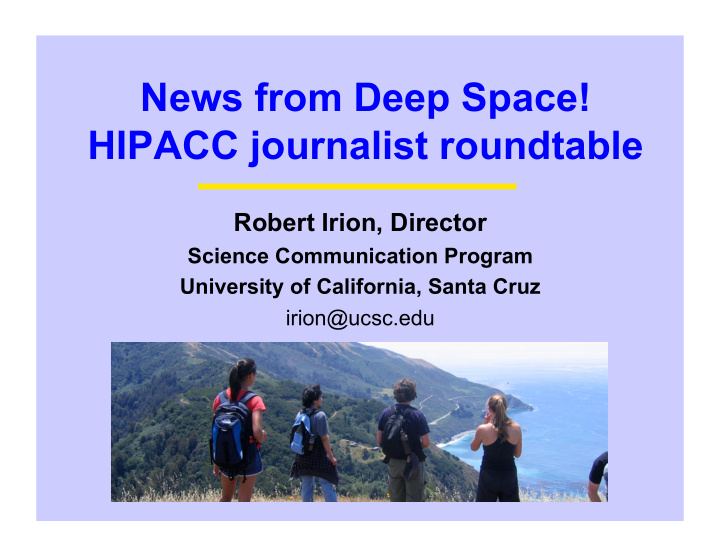



News from Deep Space! HIPACC journalist roundtable Robert Irion, Director Science Communication Program University of California, Santa Cruz irion@ucsc.edu
Stories about astronomy attract rapt audiences • The solar system is our “ home ” • The Milky Way / galaxies are beautiful • Extreme astrophysical objects rock • Cosmology compels us fundamentally • The prospects for other life (E.T., slime) hold nearly universal fascination Robert Irion / irion@ucsc.edu HIPACC / 26 June 2012
Collection of astronomy stories in Smithsonian / December 2010 Robert Irion / irion@ucsc.edu HIPACC / 26 June 2012
Simulations add a level of explanatory complexity • Computer science: Eyes glaze over • Supercomputers: Experiments in silico simply are harder to convey • As simulation stories get quantitative, editors get nervous, proportionally • Many simulations are dazzling, but: Why should readers believe them? Robert Irion / irion@ucsc.edu HIPACC / 26 June 2012
Supercomputer-generated images/movies: Amazing! We now live in a visual media environment • Space weather simulations • Supernovae / black holes / GR • The first stars and galaxies • Large-scale cosmic structure Robert Irion / irion@ucsc.edu HIPACC / 26 June 2012
HIPACC roundtable: Possible talking points • Tell stories: Delve beyond pretty pictures with scientific and personal narrative • Use metaphors and accessible analogies, from your sources or devised by you • Not all stories work for all audiences • Be Skeptical of, well, B.S. • The role of institutional press officers Robert Irion / irion@ucsc.edu HIPACC / 26 June 2012
Storytelling from HIPACC: Scientists are people, too. • Scientists: Be available to reporters • Convey why this research matters to you , and why it should matter to us • Journalists: Ask your sources for their anecdotes, frustrations, and revelations • Always keep your audience in mind Robert Irion / irion@ucsc.edu HIPACC / 26 June 2012
Good stories have vivid characters Karel Schrijver Lockheed Martin Solar and Astrophysics Laboratory Palo Alto, Calif. “ When we show these movies to our colleagues for the first time, the professional expression is generally, ‘ Whoa! ’” Robert Irion / irion@ucsc.edu HIPACC / 26 June 2012
Metaphor and analogy: Essential for the “ mind ’ s eye ” • Universal laws of physics; draw upon familiar comparisons ( One Universe ) • Help your reader visualize, e.g. a grain of sand spread within a ½ -mile sphere • Might an Earthly process be relevant? e.g. Steamboat Geyser / NS superbursts Robert Irion / irion@ucsc.edu HIPACC / 26 June 2012
• Steamboat Geyser, in the heart of Yellowstone National Park, usually shoots fountains of water 5 to 10 meters high. But at irregular intervals of years to decades, the geyser unleashes a scalding 100-meter column, followed by a deafening roar of steam for a day or more. A mysterious trigger far underground expels the deepest, hottest water from the geyser ’ s hydrothermal system in a crowd- pleasing burst. Similar outbursts happen in space, astrophysicists have learned. Powerful and unpredictable flares of energy, given the geyserlike name of “ superbursts, ” strike beneath the surfaces of a few special neutron stars—the dense, spinning corpses of stars that died in supernova explosions. Robert Irion / irion@ucsc.edu HIPACC / 26 June 2012
Don’t explode your readers’ brains Recognize how far you can go, conceptually • SciDAC Review (U.S. Department of Energy) • Physical Review Focus (American Physical Society) • Sky & Telescope / Astronomy • Science • Scientific American • New Scientist • Discover • National Geographic • Smithsonian • Chicago Tribune • Muse (Smithsonian publication, ages 10-16) • Highlights for Children • and whatever you do... Robert Irion / irion@ucsc.edu HIPACC / 26 June 2012
Please avoid plasma magnetohydrodynamics! Robert Irion / irion@ucsc.edu HIPACC / 26 June 2012
B.S. Be Skeptical / Detect B.S. / Use your B.S.+ • Eschew single-source stories • Ask challenging questions • Draw upon your own training to act as knowledgeable gatekeepers • Shoot down crap / collectively, our informed journalism enterprise can self-correct Robert Irion / irion@ucsc.edu HIPACC / 26 June 2012
Journalists and institutional press officers • High-caliber PIOs are wonderful resources; get to know who they are • Subvert churnalism; do your own reporting • Recognize that agendas do exist • Beware of scientist-issued “ news releases ” • NASA ’ s giga-tera-peta publicity machine Robert Irion / irion@ucsc.edu HIPACC / 26 June 2012
http://scicom.ucsc.edu Robert Irion / irion@ucsc.edu HIPACC / 26 June 2012
HIPACC roundtable: Possible talking points • Tell stories: Delve beyond pretty pictures with scientific and personal narrative • Use metaphor and accessible analogy, from your sources or devised by you • Not all stories work for all audiences • Be Skeptical of, well, B.S. • The role of institutional press officers Robert Irion / irion@ucsc.edu HIPACC / 26 June 2012
Recommend
More recommend